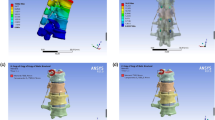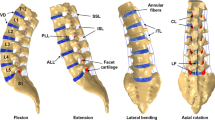Abstract
The objective of the study was to determine the sensitivity of material properties of the juvenile spine to its external and internal responses using a finite element model under compression, and flexion–extension bending moments. The methodology included exercising the 8-year-old juvenile lumbar spine using parametric procedures. The model included the vertebral centrum, growth plates, laminae, pedicles, transverse processes and spinous processes; disc annulus and nucleus; and various ligaments. The sensitivity analysis was conducted by varying the modulus of elasticity for various components. The first simulation was done using mean material properties. Additional simulations were done for each component corresponding to low and high material property variations. External displacement/rotation and internal stress–strain responses were determined under compression and flexion–extension bending. Results indicated that, under compression, disc properties were more sensitive than bone properties, implying an elevated role of the disc under this mode. Under flexion–extension moments, ligament properties were more dominant than the other components, suggesting that various ligaments of the juvenile spine play a key role in modulating bending behaviors. Changes in the growth plate stress associated with ligament properties explained the importance of the growth plate in the pediatric spine with potential implications in progressive deformities.








Similar content being viewed by others
References
Brandner ME (1970) Normal values of the vertebral body and intervertebral disk index during growth. Am J Roentgenol Radium Ther Nucl Med 110(3):618–627
Clarke EC, Appleyard RC, Bilston LE (2007) Immature sheep spines are more flexible than mature spines: an in vitro biomechanical study. Spine 32(26):2970–2979
Currey JD, Butler G (1975) The mechanical properties of bone tissue in children. J Bone Joint Surg Am 57:810–814
Davidson JD, Jebaraj C, Yoganandan N, Rajasekaran S (2010) Validation efforts and flexibilities of an eight year old human juvenile lumbar spine using a three dimensional finite element model. Med Biol Eng Comput 48:1223–1231
Davidson JD, Jebaraj C, Yoganandan N, Rajasekaran S (2010) Quantification of segmental flexibilities of juvenile lumbar spinal column using a three-dimensional finite element model (FEM), World Congress on Biomechanics 2010. Springer IFMBE Proc 31:525–528
Denoziere G, Ku DN (2006) Biomechanical comparison between fusion of two vertebrae and implantation of an artificial intervertebral disc. J Biomech 39:766–775
Dupuis R, Meyer F, Deck C, Willinger R (2006) Three-year-old child neck finite element modelization. Eur J Orthop Surg Traumatol 16:193–202
Fagan MJ, Julian S, Siddall DJ, Mohsen AM (2002) Patient-specific spine models. Part 1: finite element analysis of the lumbar intervertebral disc—a material sensitivity study. Proc Inst Mech Eng Part H J Eng Med 216:299–314
Frmyoyer J, Wierel S (2004) Adult and pediatric spine. Lippincott Williams, Philadelphia
Jebaraj C, Davidson JD, Yoganandan N, Rajasekaran S (2010) Finite element study of collapse of pediatric spine due to tuberculosis of spine. Proc Int Mech Eng Congr Expos IMECE 38678:1–7
Kumaresan S, Yoganandan N, Pintar FA (1999) Finite element analysis of the cervical spine: a material property sensitivity study. Clin Biomech 14(1):41–53
Kumaresan S, Yoganandan N, Pintar FA, Maiman DJ (2000) Biomechanical study of pediatric human cervical spine: a finite element approach. J Biomech Eng 122(1):60–71
Lee KK, Teo EC (2005) Material sensitivity study on lumbar motion segment (L2–L3) under sagittal plane loadings using probabilistic method. J Spinal Disord Tech 18(2):163–170
Lin H, Aubin CE, Parent S, Villemure I (2009) Mechanobiological bone growth: comparative analysis of two biomechanical modeling approaches. Med Biol Eng Comput 47:357–366
Lu YM, Hutton WC, Gharpuray VM (1996) Can variations in intervertebral disc height affect the mechanical function of the disc? Spine 21(19):2208–2216 (discussion 2217)
Malandrino A, Planell JA, Lacroix D (2009) Statistical factorial analysis on the poroelastic material properties sensitivity of the lumbar intervertebral disc under compression, flexion and axial rotation. J Biomech 42(16):2780–2788
Melvin JW (1995) Injury assessment reference values for the CRABI 6 month infant dummy in a rear facing infant restraint with airbag deployment. In: SAE Congress and Exposition. Society of Automotive Engineers, Detroit
Natarajan RN, Andersson GB, Patwardhan AG, Adriacchi TP (1999) Study on effect of graded facetectomy on change in lumbar motion segment torsional flexibility using three-dimensional continuum contact representation for facet joints. J Biomech Eng 121(2):215–221
Ng HW, Teo EC, Lee VS (2004) Statistical factorial analysis on the material property sensitivity of the mechanical responses of the C4–C6 under compression, anterior and posterior shear. J Biomech 37(5):771–777
Renner SM, Natarajan RN, Patwardhan AG, Harvey BM, Voronov LI, Guo BY, Anderson GBJ, An JS (2007) Novel model to analyze the effect of a large compressive follower pre-load on range of motions in a lumbar spine. J Biomech 40(6):1326–1332
Rohlmann A, Boustani HN, Bergmann G, Zander T (2010) A probabilistic finite element analysis of the stresses in the augmented vertebral body after vertebroplasty. Eur Spine J 19:1585–1595
Sairyo K, Goel VK, Masuda A, Vishnubhotla S, Faizan A, Biyani A, Ebraheim N, Yonekura D, Murakami R, Terai T (2006) Three-dimensional finite element analysis of the pediatric lumbar spine. Part I: pathomechanism of apophyseal bony ring fracture, and part II: biomechanical change as the initiating factor for pediatric isthmic spondylolisthesis at the growth plate. Eur Spine J 15(6):923–925
Shirazi-Adl SA, Shrivastava SC, Ahmed AM (1984) Stress analysis of the lumbar disc-body unit in compression. A three-dimensional nonlinear finite element study. Spine 9(2):120–134
Skogland LB, Miller JAA (1986) The length and proportions of the thoracolumbar spine in children with idiopathic scoliosis. J Bone Joint Surg B 68(5):724–728
Sylvestre PL, Villemure I, Aubin CE (2007) Finite element modeling of the growth plate in a detailed spine model. Med Biol Eng Comput 45:977–988
Vadapalli S, Sairyo K, Goel VK, Matt R, Biyani A, Khandha A, Ebraheim NA (2006) Biomechanical rationale for using polyetheretherketone (PEEK) spacers for lumbar interbody fusion—a finite element study. Spine 31(26):E992–E998
Vialle LR, Vialle E (2005) Pediatric spine injuries. Injury 36(2 Suppl 1):S104–S112
Yoganandan N, Myklebust JB, Ray G, Sances AJ (1987) Mathematical and finite element analysis of spine injuries. Crit Rev Biomed Eng 15(1):29–93
Yoganandan N, Kumaresan S, Voo L, Pintar FA (1996) Finite element applications in human cervical spine modeling. Spine 21(15):1824–1834
Author information
Authors and Affiliations
Corresponding author
Rights and permissions
About this article
Cite this article
Jebaseelan, D.D., Jebaraj, C., Yoganandan, N. et al. Sensitivity studies of pediatric material properties on juvenile lumbar spine responses using finite element analysis. Med Biol Eng Comput 50, 515–522 (2012). https://doi.org/10.1007/s11517-012-0896-6
Received:
Accepted:
Published:
Issue Date:
DOI: https://doi.org/10.1007/s11517-012-0896-6




